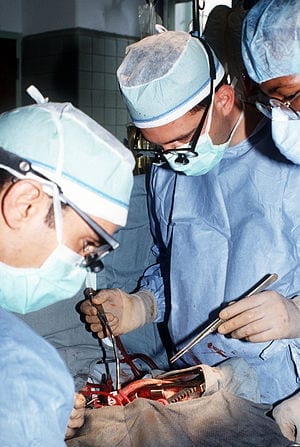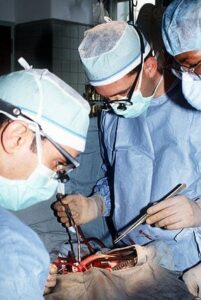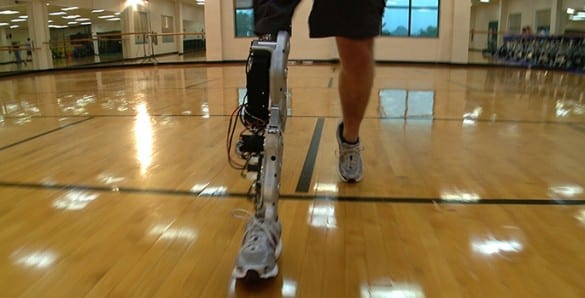Could be an important step toward the development of useful, practical telemedicine
A University of Alabama at Birmingham surgical team has performed one of the first surgeries using a virtual augmented reality technology from VIPAAR in conjunction with Google Glass, a wearable computer with an optical head-mounted display. The combination of the two technologies could be an important step toward the development of useful, practical telemedicine.
VIPAAR, which stands for Virtual Interactive Presence in Augmented Reality, is commercializing a UAB-developed technology that provides real-time, two-way, interactive video conferencing.
UAB orthopedic surgeon Brent Ponce, M.D., performed a shoulder replacement surgery Sept. 12 at UAB Highlands Hospital in Birmingham. Watching and interacting with Ponce via the VIPAAR technology was Phani Dantuluri, M.D., from his office in Atlanta.
Ponce wore Google Glass during the operation. The built-in camera transmitted the image of the surgical field to Dantuluri. The VIPAAR technology allowed Dantuluri to see exactly what Ponce saw in the operating room and introduce his hands or instruments into the virtual surgical field. At the same time, Ponce saw Dantuluri’s hands and instruments in his heads-up display, along with his own field of view, as a merged-reality environment.
“It’s not unlike the line marking a first down that a television broadcast adds to the screen while televising a football game,” said Ponce. “You see the line, although it’s not really on the field. Using VIPAAR, a remote surgeon is able to put his or her hands into the surgical field and provide collaboration and assistance.”
The two surgeons were able to discuss the case in a truly interactive fashion since Dantuluri could watch Ponce perform the surgery and simultaneously introduce his hands or instruments into Ponce’s view as if they were standing next to each other during the case.
“It’s real-time, real-life, right there, as opposed to a Skype or video conference call, which allows for dialogue back and forth but is not really interactive,” said Ponce.
UAB physicians say this kind of technology could greatly enhance patient care by allowing a veteran surgeon to remotely provide valuable expertise to less experienced surgeons. VIPAAR owes its origins to UAB neurosurgeon Barton Guthrie, M.D., who some 10 years ago grew dissatisfied with the current state of telemedicine.
| “It’s not unlike the line marking a first down that a television broadcast adds to the screen while televising a football game. You see the line, although it’s not really on the field. Using VIPAAR, a remote surgeon is able to put his or her hands into the surgical field and provide collaboration and assistance.” |
“So-called ‘telemedicine’ was little more than a telephone call between two physicians,” Guthrie recalled. “A surgeon in a small, regional hospital might call looking for guidance on a difficult procedure — one that perhaps I’d done a hundred times but he’d done only once or twice. How advantageous to the patient would it be if we could get our hands and instruments virtually into the field of view of a surgeon who has skills and training and lacks only experience?”
“The paradigm of the telephone consultation is, ‘Do the best you can and send the patient to me when stable,’ while the paradigm with VIPAAR’s technology is ‘Get me to the patient. Let’s get my expertise and experience to the physician on the front line,’ and I think we can implement that concept with these technologies,” Guthrie said.
Ponce says VIPAAR’s capabilities allow the remote physician to point out anatomy, provide guidance or even demonstrate the proper positioning of instruments. He says it could be an invaluable tool for teaching residents or helping surgeons first learning a new procedure.
“This system is able to provide that help from an expert who is not on-site, guiding and teaching new skills while enhancing patient safety and outcomes,” he said. “It provides a safety net to improve patient care by having that assistance from an expert who is not in the room.”
Go deeper with Bing News on:
Virtual surgery
- Gen Y Speaks: I was diagnosed with brain cancer 3 months before my first child was born. The hardest part was learning to lean on others
I was 32 years old, eagerly awaiting the arrival of my first child, while getting ready to start a promising new career. But life had other plans in store for me.
- Prospect Nate Lavender likely set for Tommy John surgery
Mets relief prospect Nate Lavender, who entered this season on the cusp of the Majors, has ligament damage in his left elbow and is likely headed for Tommy John surgery, a source said Saturday.
- Evolving Horizons: A Journey through 30 Years of Plastic Surgery Advancements
Dr. Sunil Kalda, MS, Mch in Plastic Surgery is a distinguished plastic surgeon in Raipur, Chhattisgarh. He has been on the forefront of innovation in the field of cosmetic and reconstructive surgery.
- Why NFL commissioner Roger Goodell hugs NFL draftees — and why he may not this year
Boos and hugs have been part of NFL draft day traditions since Roger Goodell became the league’s commissioner.
- Roger Goodell’s back surgery casts doubt on draft day hugs
Roger Goodell's recent back surgery casts doubt on his ability to participate in traditional celebratory hugs with first-round draft picks.
Go deeper with Google Headlines on:
Virtual surgery
[google_news title=”” keyword=”Virtual surgery” num_posts=”5″ blurb_length=”0″ show_thumb=”left”]
Go deeper with Bing News on:
Remote surgery
- Ruling: Iowa state auditor must provide more evidence to justify withholding emails
The state auditor's office must do more to justify its decision to withhold from public release emails between his office and two journalists, the Iowa Supreme Court ruled.
- The Xiaomi Pad 6S Pro 12.4 is a versatile tablet with neat tricks up its sleeve
At a glance Expert's Rating Pros ・Scintillating and smooth display ・Good battery life ・120W fast charging ・Focus Pen stylus is great fun Cons ・Limited software support ・Stylus not included ・Officially ...
- Telehealth, AI, and the evolution of remote surgical assistance
Telehealth has greatly increased patient engagement during the pandemic while AI and remote patient monitoring can increase the chances of detecting diseases or conditions early with real-time ...
- Kovalainen returns to F1 duties after surgery
Heikki Kovalainen is on the road to recovery, following open-heart surgery. It emerged in March that the former Formula 1 (...) ...
- How 6G Research Will Revolutionize Mobile Experiences
By 2030, 6G is expected to be commercially available, revolutionizing connectivity with lightning-fast speeds, unprecedented bandwidths, and ultra-low latencies. It will transform various sectors, ...
Go deeper with Google Headlines on:
Remote surgery
[google_news title=”” keyword=”remote surgery” num_posts=”5″ blurb_length=”0″ show_thumb=”left”]












